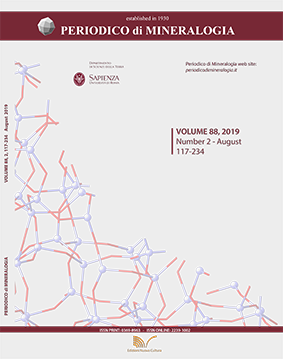Petrological aspects of the Bayazeh Paleozoic ophiolite (Central Iran); implications for Paleo-Tethys subduction
DOI:
https://doi.org/10.2451/2019PM835Keywords:
Ophiolite, Supra-subduction zone, Paleo-Tethys, Paleozoic, Bayazeh, Central Iran.Abstract
The Paleozoic Bayazeh ophiolite is situated in the western part of the Central-East Iranian Microcontinent (CEIM). This ophiolite consists of serpentinized peridotite, metagabbro, metapicrite, serpentinite and amphibole-bearing listwaenite which are covered by schists and marbles. Serpentinites in the Bayazeh ophiolite are produced from development of serpentinization process in the mantle peridotites. The composition of primary chromian spinel cores (with average content of Cr~ 9.9, Mg~ 4.3, Ti< 0.01 and Fe3+< 0.5) in the Bayazeh serpentinites suggests an ophiolitic origin and high degrees of partial melting of a depleted harzburgite mantle peridotite source in a supra-subduction zone geotectonic setting. The texture and mineral assemblage of amphibole-bearing listwaenites and association of their outcrops with serpentinites indicate that the studied listwaenites were generated by prograde metamorphism under upper greenschist to lower amphibolite facies P-T conditions from a carbonated serpentinite. Geochemical characteristics of the Bayazeh metagabbros, indicate high value of large ion lithophile elements, high content of light rare earth elements, low degree of HREE fractionation (e.g. (Gd/Yb)CN = 0.95-1.21), low contents of high-field strength elements and large variation of the LILE/HFSE ratios (e.g. Sr/Sm = 47.83-564.67), point to the role of lithospheric mantle and effect of fluids derived from the subducted slab in their formation. Mineralogical characteristics (e.g. presence of primary hydrous minerals such as phlogopite with 9-10 vol.%) and chemical composition of the Bayazeh metapicrites suggest derivation from a metasomatized asthenospheric mantle spinel- and amphibole-bearing peridotite. Metasomatic enrichment of the mantle source probably occurred by fluids released during subduction of the Paleo-Tethys Ocean beneath the Central Iran. Subduction of the Paleo-Tethys from the Early to the Late Paleozoic is the cause of volatile enrichment and mantle metasomatism in the western part of the Central-East Iranian Microcontinent.


